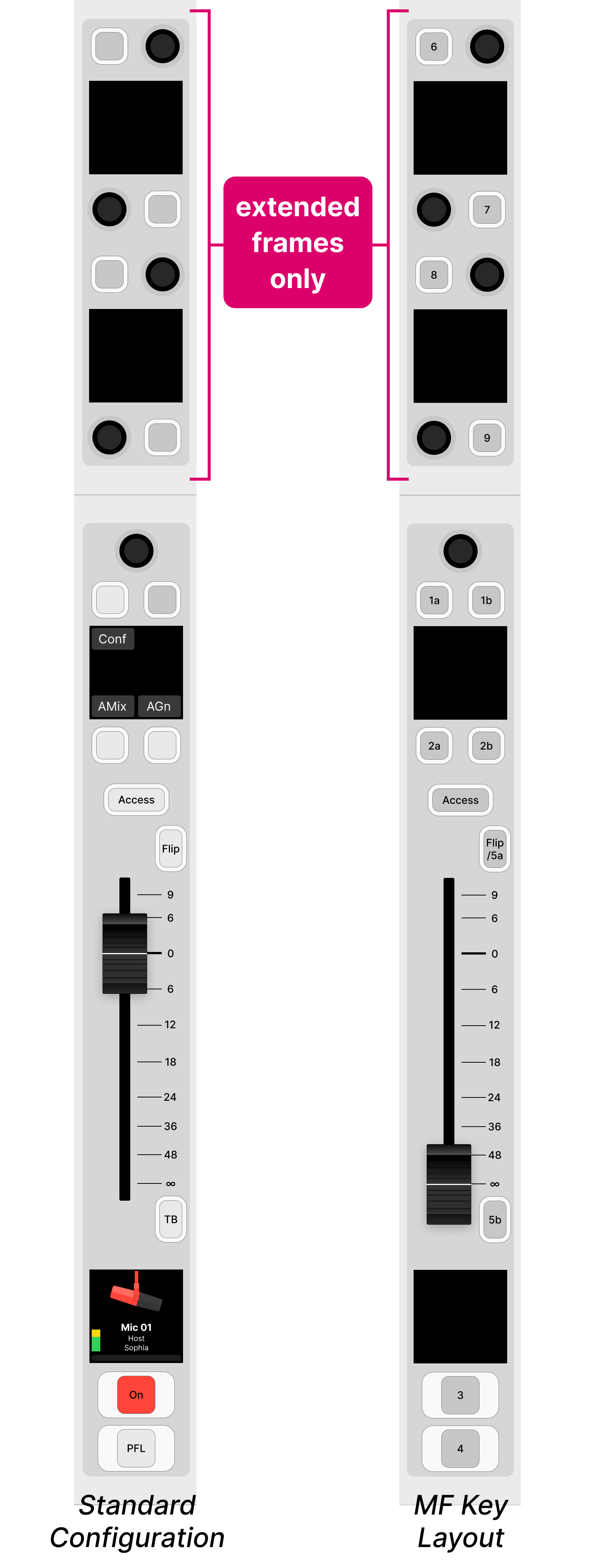diamond - Source-Specific Functions
The MF keys on each fader strip are programmed by the configuration and are defined per source. They can be used to customize the functionality of the console. For example, to have PFL on a large or small MF key.
This topic describes the available keys and their most common functions.
MF Keys
On a standard frame, each fader strip has 8 MF keys:
- MF keys 1a, 1b, 2a and 2b are labelled by the display. This makes them suitable for functions that vary depending on the type of source.
- MF keys 3, 4, 5a* and 5b are labelled by foil-printed inserts and so, usually, they are configured for the same function for all sources. The exception is if the surface supports more than one operating station. In this instance, each frame can be labeled differently and have access to a different set of sources with different MF key functions.
*MF key 5a is only available if Layer 2 is disabled by the configuration.
If the frame is fitted with a Rotary Fader Extension module, then this adds another 4 sets of controls to the fader strip. The main purpose is to provide localized source parameter control (described later). However, when source parameter control is switched off, they operate as MF keys 6 to 9.
- MF keys 6, 7, 8 and 9 are labelled by the displays, making them suitable for functions that vary depending on the type of source. Note that, in this mode, the four rotary controls cannot be configured and have no function.
The image below shows an example of the functionality and the MF key layout.

Typical Functions
Depending on the configuration, you may have access to some or all of the following functions.
Conf (Conference)
This key assigns the source onto the conference bus. Once Conf is enabled on more than one source, an N-1 mix is created. This can be routed back to the source (e.g. to their earpiece) so that they can hear the conference mix minus themselves while off-air.
The Conf key has four possible states. The colors used can be modified by the ON-AIR Designer. The following colors are used in the standard configuration:
- Dim white = conference off.
- Dim yellow = conference on for one source (Conf active).
- Full yellow = conference on for more than one source (Conf audio).
- Full green = conference on and fader open (Conf prepare).
"Conf prepare" occurs if you select Conf on an open fader. Nothing happens until you close the fader; once the fader is closed, Conf becomes active.
The conference system is described in more detail later. See Conference & N-1.
AMix (Automix)
This key enables automixing. Once AMix is enabled on more than one source, the mix levels are adjusted automatically.
The AMix key has two possible states. The colors used can be modified by the ON-AIR Designer. The following colors are used in the standard configuration:
- Dim white = automix off.
- Full yellow = automix on.
In diamond, up to 4 independent automix groups can be configured. The group number, and other parameters, are adjusted from the AGC controls when a source is in access.
The automix parameters are described in more detail later. See Automix.
AGn (Auto Gain)
This key enables auto gain (on mic sources). It can be used to set the analog (mic preamp) gain automatically.
The AGn key has two possible states. The colors used can be modified by the ON-AIR Designer. The following colors are used in the standard configuration:
- Dim white = autogain off.
- Flashing yellow = autogain adjustment is in process.
How to use auto gain is described later. See Using Auto Gain.
TB (Talkback)
This key talks to the source via its N-1 return.
In the standard configuration, the operation is momentary so press and hold the TB key to activate talkback.
The TB key has two possible states. The colors used can be modified by the ON-AIR Designer. The following colors are used in the standard configuration:
- Dim white = talkback off.
- Full red = talkback on (active).
ON (Channel On/Off)
This key turns the channel on or off.
The ON key has two possible states. The colors used can be modified by the ON-AIR Designer. The following colors are used in the standard configuration:
- Dim white = channel off.
- Full red = channel on.
In the standard configuration, the channel "on" state is conditional on the fader position. This allows you to open and close a fader automatically as follows:
- To quickly turn on a channel, press the ON key - it lights in red and the fader opens to 0dB.
- To quickly turn off a channel, press the ON key again - the light goes out and the fader closes.
- To fade the level in or out, move the fader - the channel ON key indicates the on/off status.
PFL (Pre-Fader Listen)
This key assigns the source to the PFL bus. It can be used to listen to a source before opening its fader.
- Dim white = PFL off.
- Full green = PFL on and fader closed (PFL active).
- Dim green = PFL on and fader open (PFL prepare).
"PFL prepare" occurs if you select PFL on an open fader. Nothing happens until you close the fader; once the fader is closed, PFL becomes active.
In the standard configuration, the PFL bus is switched to the headphone (HP) monitoring whenever a PFL is active. The previous monitor source is re-instated once all active PFLs are cleared.
The PFL system is described in more detail later. See PFL.